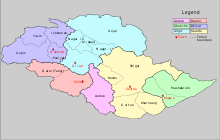Dardistan
Dardistan (Land of the Dardu, formerly Darada) is the largely historical name for a landscape in the Himalayas, northwesternmost part of Kashmir (and thus controlled by Pakistan), bounded on the north by the Karakoram (mean pass height 5550 m), in the west by the mountain range terminating Chitral in the north (with peaks up to 5594 m), in the east by the mountain range between the Indus and the Krishnaganga (Diamer, 8114 m) and in the northeast by the landscapes of Rongdo and Balti. Dardistan thus measures about 100 km in both north-south and east-west directions. The name Dardistan was used mainly by Europeans and by the inhabitants of Kashmir bordering on the other side of the Indus.
Administratively, Dardistan is part of the Pakistani Special Territory of Gilgit-Baltistan, called Northern Areas until 2009, and comprises two districts of this administrative unit:
The highlands consist of many valleys, the mean altitude of which is 1500 to 2000 m. The Gilgit valley was first explored by Europeans through Hayward, who was murdered here in 1870, and through Leitner, whom the Punjab government sent there in 1864 for linguistic research. A first expedition under Adolf von Schlagintweit failed in 1856 owing to insurrections in Gilgit. The Gilgit valley is rich in wine and apricots; wheat is also grown here.
The valleys on both sides of the Indus are similar to nearby Chitral in terms of climate and cultivated products; the mountainous areas, on the other hand, are rather inhospitable. There are also gold deposits in the area that have been exploited for centuries.
Dardistan is relatively inaccessible. Only Gilgit and the upper Indus valley are accessible by developed roads. The local Dardu people profess Shiite Islam and were Buddhist in pre-Islamic times. The two most important tribes are the Jeshkun and the Shin, who successively advanced into the area. The Jeshkun are partly identified with the Yuezhi, who migrated to Bactria from Sinkiang in the 2nd century BC. The Shin, on the other hand, are probably of Indian origin, since the cow is revered as sacred among them. In the way of life the Dardu resemble the other Kashmir inhabitants, but the language is related to Sanskrit and consists of several dialects, often including words of Persian origin; also the characters used are Persian.
Historically, small chanats have formed in the valleys, mostly in battles with the Raja of Kashmir. After the latter became a vassal of the British Crown in 1846, the high mountain valleys of Dardistan also came under the influence of the British, who pushed exploration and development of the area, especially since Kashmir was considered a strategically important outpost against possible Russian incursions into India. After India and Pakistan were granted independence, the two states went to war over Kashmir, which ended in 1949 with the establishment of the Line of Control.

The districts of Diamir and Astore belong to Dardistan.
Search within the encyclopedia